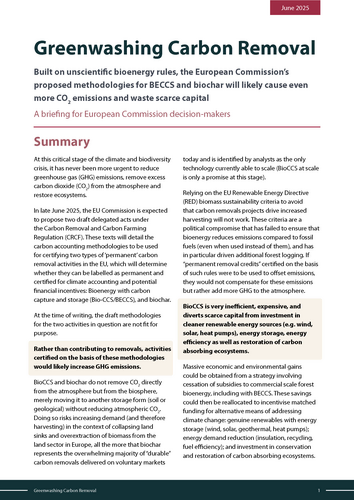Greenwashing Carbon Removal -briefing
Will the EU’s carbon removals policy remove carbon from the atmosphere, or forests from the land?
Urgent action is needed to ensure the upcoming EU carbon removal rules for biomass-based activities are cost-effective and do not worsen the climate crisis. Today, 41 NGOs including Ei polteta tulevaisuutta -campaign have sent a briefing to the political leadership of the European Commission, members of the European Parliament and EU Member States to alert them that current draft rules are not fit for purpose. They also suggest remedies.
In early July 2025, the European Commission’s DG CLIMA is expected to propose two delegated acts under the Carbon Removal and Carbon Farming Regulation (CRCF).
These texts will detail the accounting methodologies to be used for certifying two types of ‘permanent’ carbon removal activities, Bioenergy with Carbon Capture and Storage (Bio-CCS/BECCS), and biochar. The new rules will determine whether claimed removals can be labelled as permanent and certified. This would allow them to be counted in climate budgets, and mean they could benefit from potential financial incentives such as being included on the EU Emissions Trading System (ETS), which could drive demand.
At this critical stage of the climate and biodiversity crisis, it has never been more urgent to reduce greenhouse gas (GHG) emissions, remove excess carbon dioxide (CO2) from the atmosphere, and restore ecosystems. NGOs have therefore raised concerns that draft methodologies for BioCCS/BECCS and biochar would achieve the opposite as:
- They are not informed by science but the EU’s sustainability criteria for biomass, which are the outcome of political compromises that have left them unable to protect the climate and forests. As a result, rather than contributing to removals, activities certified on the basis of these methodologies would likely increase GHG emissions.
- BioCCS and biochar remove CO2 from the biosphere, not the atmosphere. As eligible BioCCS and biochar biomass feedstocks are not limited to unused biomass residues, they would drive additional logging in forests and a further degradation of the land carbon sink, yet the impacts on the land sector are ignored even though EU ecosystems are losing the ability to remove CO2 from the atmosphere.
- They consider adding biochar to soils to be classified as a permanent form of CO2 removal despite there being no field data demonstrating in situ permanence for the period of time needed, and do not mandate measuring how carbon soil levels evolve between biochar application and the end of the project. The large amounts of carbon emitted during the biochar production process would also be ignored.
- BioCCS is inefficient, expensive, unproven at scale, unlikely to remove CO2 from the atmosphere for many years, and diverts scarce capital from investment in energy efficiency, cleaner renewable energy sources (such as wind, solar, and heat pumps), energy storage, and the restoration of carbon absorbing ecosystems.
- The draft methodologies contradict several binding provisions of the CRCF Regulation, including the requirements for scientific integrity, environmental safeguards, and full life-cycle accounting. As such, they would amount to “regulatory greenwashing’’.
